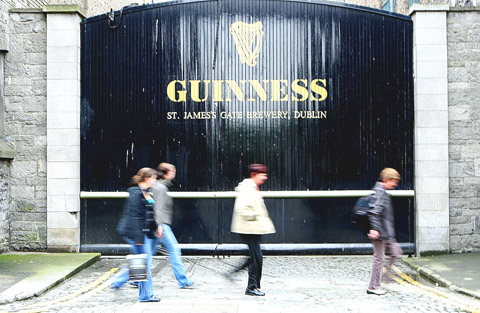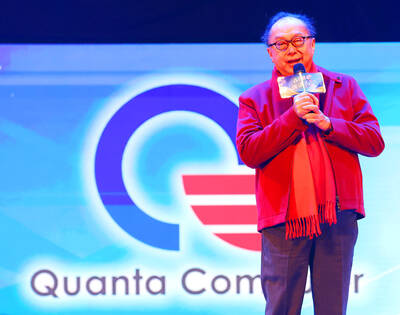For two-and-a-half centuries St James’ Gate in Dublin has been the home of Guinness.
Diageo, the famed Irish stout’s British-based parent company and the world’s largest producer of alcoholic drinks, brews a billion pints a year of the “black stuff.”
Recent weeks were abuzz with press speculation that Diageo would sell the world brand’s historic birthplace and build a new brewery outside the city. Irish Guinness drinkers had taken it hard.

PHOTO: AP
“If Guinness pulled out of St James’s Gate, I’d never drink Guinness again — and I have been drinking Guinness for 38 years, with an average of 40 pints a week,” said Martin O’Mahony, a 59-year-old engineer in Cork city on Ireland’s south coast.
But the speculation has — in part at least — been proven wrong. Diageo said on Friday it plans to invest 650 million euros (US$1 billion) in the St James’s Gate brewery — and also a new production plant at a location yet to be announced outside Dublin.
“Our ambition is to create a brewing hub which will meet the highest standards of technology, efficiency and environmental management,” said Diageo chief executive Paul Walsh.
Guinness brews its distinctive stout not only in Ireland but also at global locations that include Nigeria, which has the company’s third best-selling market after the UK and Ireland.
Beside Guinness, Diageo offers many international known brands like Smirnoff vodka, Johnnie Walker whisky, Captain Morgan rum and Baileys liqueur.
Guinness’ plans include an investment of 70 million euros in parts of the existing facilities at St James’s Gate, a Diageo spokesman said.
After upgrading, about 50 percent of the existing brewing facilities at St James’s Gate would be sold, the spokesman said.
The new plant would produce Guinness to meet growing export demand, plus other ales and lagers, from 2013 onwards. St James’ would produce Guinness primarily for the Irish and British markets.
Simultaneously, Diageo plans to close down two breweries in smaller towns in Ireland’s north, and southwest of Dublin, involving a net reduction of 250 employees in Ireland.
Guinness workers can look back on a long history. The first to brew beer at St James’ Gate was Giles Mee in 1670. The site takes its name from one of the old gates into Dublin.
In 1759, Arthur Guinness began brewing there. West Indies Porter — a precursor to modern-day Guinness — was first brewed in 1801.
In 1886, Guinness was the first major brewery listed on the London Stock Exchange, being the largest brewery in the world with annual production of 1.2 million barrels.
Today, St James’ Gate site is Ireland’s biggest tourist attraction with more than 940,000 visitors per year,at 12 euros a head.
The original storehouse, a seven-floor building constructed in 1904, serves as a visitor center with bars, shops and a training center.
Originally, beer was stored here in huge vessels of oak and pine, later of aluminum. In the 1960s, the storehouse had an overall capacity of 39,300 barrels.
Under Diageo’s current plans, the historic storehouse will continue to develop to accommodate growing visitor numbers, now expected to surpass 1 million people a year, the company said.
Naturally, the storehouse is not the only thing foreigners are attracted to.
“I like Guinness,” said Melow Bivona, a 26-year old who works for Apple Inc in Ireland.
“If you taste Guinness, it tastes like a bit of Ireland,” he said.
It’s a view shared by locals.
“Guinness is Ireland,” said 40-pints-a-week O’Mahony.

Quanta Computer Inc (廣達) chairman Barry Lam (林百里) is expected to share his views about the artificial intelligence (AI) industry’s prospects during his speech at the company’s 37th anniversary ceremony, as AI servers have become a new growth engine for the equipment manufacturing service provider. Lam’s speech is much anticipated, as Quanta has risen as one of the world’s major AI server suppliers. The company reported a 30 percent year-on-year growth in consolidated revenue to NT$1.41 trillion (US$43.35 billion) last year, thanks to fast-growing demand for servers, especially those with AI capabilities. The company told investors in November last year that

Intel Corp has named Tasha Chuang (莊蓓瑜) to lead Intel Taiwan in a bid to reinforce relations between the company and its Taiwanese partners. The appointment of Chuang as general manager for Intel Taiwan takes effect on Thursday, the firm said in a statement yesterday. Chuang is to lead her team in Taiwan to pursue product development and sales growth in an effort to reinforce the company’s ties with its partners and clients, Intel said. Chuang was previously in charge of managing Intel’s ties with leading Taiwanese PC brand Asustek Computer Inc (華碩), which included helping Asustek strengthen its global businesses, the company

Taiwanese suppliers to Taiwan Semiconductor Manufacturing Co. (TSMC, 台積電) are expected to follow the contract chipmaker’s step to invest in the US, but their relocation may be seven to eight years away, Minister of Economic Affairs J.W. Kuo (郭智輝) said yesterday. When asked by opposition Chinese Nationalist Party (KMT) Legislator Niu Hsu-ting (牛煦庭) in the legislature about growing concerns that TSMC’s huge investments in the US will prompt its suppliers to follow suit, Kuo said based on the chipmaker’s current limited production volume, it is unlikely to lead its supply chain to go there for now. “Unless TSMC completes its planned six

TikTok abounds with viral videos accusing prestigious brands of secretly manufacturing luxury goods in China so they can be sold at cut prices. However, while these “revelations” are spurious, behind them lurks a well-oiled machine for selling counterfeit goods that is making the most of the confusion surrounding trade tariffs. Chinese content creators who portray themselves as workers or subcontractors in the luxury goods business claim that Beijing has lifted confidentiality clauses on local subcontractors as a way to respond to the huge hike in customs duties imposed on China by US President Donald Trump. They say this Chinese decision, of which Agence